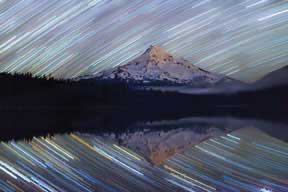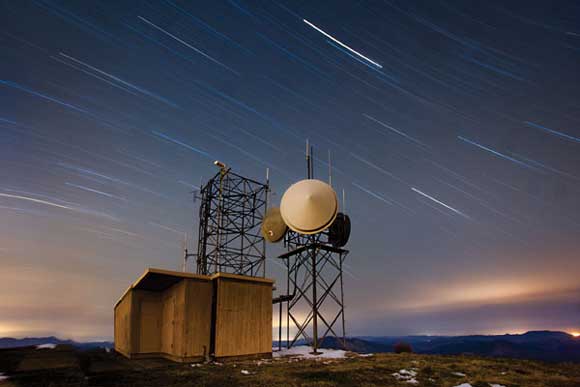Shooting Stars – Part II
Okay, you have picked your evening and location, you are there and have your camera ready to shoot – what do you do now? I begin by taking an overexposed shot that will show me on my camera’s LCD screen what is going on and is available around me much better than my own eyes can see. To do this I turn the ISO up as high as it will go, set the aperture as wide open as it can be, and turn exposure to 30 seconds (if you have a cable release or remote, use it for a 2-5 minute exposure), and put the focus to infinity. Doing this, I will get an image that is usually too bright and too noisy. This is OK because it is only a test shot that shows me if there are any passing clouds overhead blocking the stars, the sources of light pollution from cities on the horizon, contours and features in the landscape around me, and I can take test shots at various directions to locate the Milky Way. All this information is used to decide the composition of my shot.
 After you decide on your composition, change your settings for a more balanced exposure. To start out, one of my common settings when using my Canon 5D Mark II and 24-70mm f/2.8 lens is: ISO 3200-4000, f/2.8 for a 25-second exposure. If you don’t have a f/2.8 aperture setting, use the widest that you have. Your equipment’s abilities will affect the overall brightness, but one of my most published star images was shot with my old Canon EOS 30D and the 10-22mm f/3.5-4.5 lens.
After you decide on your composition, change your settings for a more balanced exposure. To start out, one of my common settings when using my Canon 5D Mark II and 24-70mm f/2.8 lens is: ISO 3200-4000, f/2.8 for a 25-second exposure. If you don’t have a f/2.8 aperture setting, use the widest that you have. Your equipment’s abilities will affect the overall brightness, but one of my most published star images was shot with my old Canon EOS 30D and the 10-22mm f/3.5-4.5 lens.
It is up to you to decide the combination of settings to make your exposure. I recommend you experiment changing all three so you can compare results when you are on your computer editing back at home. Here is what to expect when changing your settings:
- Increasing your ISO brightens the image but increases image noise and limits potential exposure length.
- Opening your aperture brightens the image, but decreases your depth of field, therefore making focusing much trickier in dark conditions.
- Extending your exposure will brighten your image but if exposed too long you will record the movement of the stars across the sky. The formula to know the maximum exposure you can use without getting star trails is: ‘600/focal length = exposure (in seconds)’. For example a 20mm lens would be 600/20mm, equalling a maximum 30-second exposure.
All these factors may seem intimidating at first, but with trial and error, you will quickly catch on. Here are a few more tips to smooth out the process for your first time:
- For better focus, use live view to zoom into the brightest star you see and turn your focus until the star is a sharp point.
- Put a building or structure in the composition and use your torch or headlamp to illuminate it during the exposure.
- Get a cable release, remote or use a timer to avoid camera shake and take exposures longer than 30 seconds that give you brighter foreground that you can mask in later using Photoshop.
- For fun, get in the shot itself and use your torch or headlamp aimed at the camera to ‘paint’ words or shapes into the image. Long exposures won’t reveal your presence in the final shot.
- Lastly, when you finally get away from the city and under the stars, make sure you take some time to step away from the camera and just look up, to enjoy the experience.





